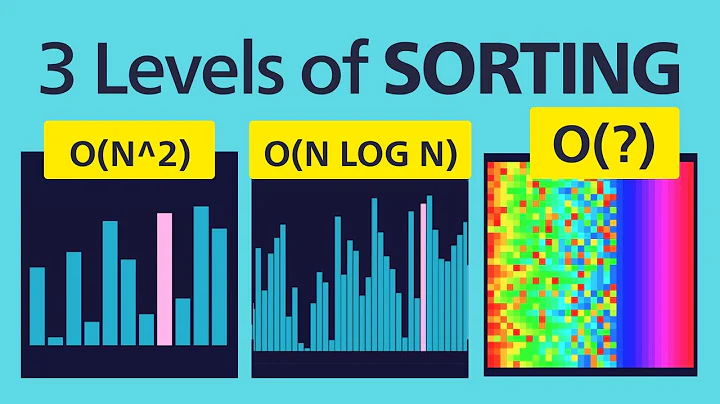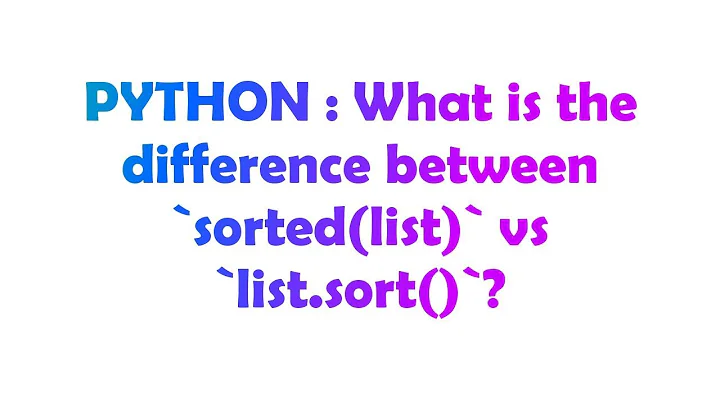What is the difference between `sorted(list)` vs `list.sort()`?
Solution 1
sorted() returns a new sorted list, leaving the original list unaffected. list.sort() sorts the list in-place, mutating the list indices, and returns None (like all in-place operations).
sorted() works on any iterable, not just lists. Strings, tuples, dictionaries (you'll get the keys), generators, etc., returning a list containing all elements, sorted.
Use
list.sort()when you want to mutate the list,sorted()when you want a new sorted object back. Usesorted()when you want to sort something that is an iterable, not a list yet.For lists,
list.sort()is faster thansorted()because it doesn't have to create a copy. For any other iterable, you have no choice.No, you cannot retrieve the original positions. Once you called
list.sort()the original order is gone.
Solution 2
What is the difference between
sorted(list)vslist.sort()?
-
list.sortmutates the list in-place & returnsNone -
sortedtakes any iterable & returns a new list, sorted.
sorted is equivalent to this Python implementation, but the CPython builtin function should run measurably faster as it is written in C:
def sorted(iterable, key=None):
new_list = list(iterable) # make a new list
new_list.sort(key=key) # sort it
return new_list # return it
when to use which?
- Use
list.sortwhen you do not wish to retain the original sort order (Thus you will be able to reuse the list in-place in memory.) and when you are the sole owner of the list (if the list is shared by other code and you mutate it, you could introduce bugs where that list is used.) - Use
sortedwhen you want to retain the original sort order or when you wish to create a new list that only your local code owns.
Can a list's original positions be retrieved after list.sort()?
No - unless you made a copy yourself, that information is lost because the sort is done in-place.
"And which is faster? And how much faster?"
To illustrate the penalty of creating a new list, use the timeit module, here's our setup:
import timeit
setup = """
import random
lists = [list(range(10000)) for _ in range(1000)] # list of lists
for l in lists:
random.shuffle(l) # shuffle each list
shuffled_iter = iter(lists) # wrap as iterator so next() yields one at a time
"""
And here's our results for a list of randomly arranged 10000 integers, as we can see here, we've disproven an older list creation expense myth:
Python 2.7
>>> timeit.repeat("next(shuffled_iter).sort()", setup=setup, number = 1000)
[3.75168503401801, 3.7473005310166627, 3.753129180986434]
>>> timeit.repeat("sorted(next(shuffled_iter))", setup=setup, number = 1000)
[3.702025591977872, 3.709248117986135, 3.71071034099441]
Python 3
>>> timeit.repeat("next(shuffled_iter).sort()", setup=setup, number = 1000)
[2.797430992126465, 2.796825885772705, 2.7744789123535156]
>>> timeit.repeat("sorted(next(shuffled_iter))", setup=setup, number = 1000)
[2.675589084625244, 2.8019039630889893, 2.849375009536743]
After some feedback, I decided another test would be desirable with different characteristics. Here I provide the same randomly ordered list of 100,000 in length for each iteration 1,000 times.
import timeit
setup = """
import random
random.seed(0)
lst = list(range(100000))
random.shuffle(lst)
"""
I interpret this larger sort's difference coming from the copying mentioned by Martijn, but it does not dominate to the point stated in the older more popular answer here, here the increase in time is only about 10%
>>> timeit.repeat("lst[:].sort()", setup=setup, number = 10000)
[572.919036605, 573.1384446719999, 568.5923951]
>>> timeit.repeat("sorted(lst[:])", setup=setup, number = 10000)
[647.0584738299999, 653.4040515829997, 657.9457361929999]
I also ran the above on a much smaller sort, and saw that the new sorted copy version still takes about 2% longer running time on a sort of 1000 length.
Poke ran his own code as well, here's the code:
setup = '''
import random
random.seed(12122353453462456)
lst = list(range({length}))
random.shuffle(lst)
lists = [lst[:] for _ in range({repeats})]
it = iter(lists)
'''
t1 = 'l = next(it); l.sort()'
t2 = 'l = next(it); sorted(l)'
length = 10 ** 7
repeats = 10 ** 2
print(length, repeats)
for t in t1, t2:
print(t)
print(timeit(t, setup=setup.format(length=length, repeats=repeats), number=repeats))
He found for 1000000 length sort, (ran 100 times) a similar result, but only about a 5% increase in time, here's the output:
10000000 100
l = next(it); l.sort()
610.5015971539542
l = next(it); sorted(l)
646.7786222379655
Conclusion:
A large sized list being sorted with sorted making a copy will likely dominate differences, but the sorting itself dominates the operation, and organizing your code around these differences would be premature optimization. I would use sorted when I need a new sorted list of the data, and I would use list.sort when I need to sort a list in-place, and let that determine my usage.
Solution 3
The main difference is that sorted(some_list) returns a new list:
a = [3, 2, 1]
print sorted(a) # new list
print a # is not modified
and some_list.sort(), sorts the list in place:
a = [3, 2, 1]
print a.sort() # in place
print a # it's modified
Note that since a.sort() doesn't return anything, print a.sort() will print None.
Can a list original positions be retrieved after list.sort()?
No, because it modifies the original list.
Solution 4
Here are a few simple examples to see the difference in action:
See the list of numbers here:
nums = [1, 9, -3, 4, 8, 5, 7, 14]
When calling sorted on this list, sorted will make a copy of the list. (Meaning your original list will remain unchanged.)
Let's see.
sorted(nums)
returns
[-3, 1, 4, 5, 7, 8, 9, 14]
Looking at the nums again
nums
We see the original list (unaltered and NOT sorted.). sorted did not change the original list
[1, 2, -3, 4, 8, 5, 7, 14]
Taking the same nums list and applying the sort function on it, will change the actual list.
Let's see.
Starting with our nums list to make sure, the content is still the same.
nums
[-3, 1, 4, 5, 7, 8, 9, 14]
nums.sort()
Now the original nums list is changed and looking at nums we see our original list has changed and is now sorted.
nums
[-3, 1, 2, 4, 5, 7, 8, 14]
Solution 5
Note: Simplest difference between sort() and sorted() is: sort() doesn't return any value while, sorted() returns an iterable list.
sort() doesn't return any value.
The sort() method just sorts the elements of a given list in a specific order - Ascending or Descending without returning any value.
The syntax of sort() method is:
list.sort(key=..., reverse=...)
Alternatively, you can also use Python's in-built function sorted() for the same purpose. sorted function return sorted list
list=sorted(list, key=..., reverse=...)
Related videos on Youtube
Comments
-
alvas about 4 years
list.sort()sorts the list and replaces the original list, whereassorted(list)returns a sorted copy of the list, without changing the original list.- When is one preferred over the other?
- Which is more efficient? By how much?
- Can a list be reverted to the unsorted state after
list.sort()has been performed?
-
smci over 4 yearsBeware if you (accidentally) call
sorted()on a string argument but think it's a list, you get a list result, not a string:sorted("abcd", reverse=True)gives['d', 'c', 'b', 'a']not"dcba" -
 ShadowRanger over 3 yearsNote for folks looking for duplicates: A number of questions related to
ShadowRanger over 3 yearsNote for folks looking for duplicates: A number of questions related tolist.sort()returningNone, not a newlist, are being duped here, when they'd be better off duped to the more specific Why does “return list.sort()” return None, not the list?.
-
Burhan Khalid about 10 years
print a.sort()won't print anything. -
 Christian Tapia about 10 yearsIt will print
Christian Tapia about 10 yearsIt will printNone, I will clarify that. -
Martijn Pieters about 10 yearsThe generator setup is nice, but I wouldn't draw the conclusion that you busted a myth too quickly. The fact remains that
sorted()has to allocate a new list object and copy the references; the rest of the code paths are identical. See if you can run the same tests with larger lists. Compare it with just creating copies of lists and see if you can replicate the differences you found, etc. -
user1767754 over 6 yearsIn general, when a python function returns
None, it is a sign, that the operations are done in place, that's why, when you want to printlist.sort()it returns None. -
 PM 2Ring about 6 years"The .sort() function stores the value of new list directly in the list variable" Huh? What new list? There's no new list. The
PM 2Ring about 6 years"The .sort() function stores the value of new list directly in the list variable" Huh? What new list? There's no new list. Thelist.sort()method sorts the list object in-place. -
 PM 2Ring about 6 yearsAlso, what is this supposed to mean? "sometimes .sort() method acts as function, or say that it takes arguments in it."
PM 2Ring about 6 yearsAlso, what is this supposed to mean? "sometimes .sort() method acts as function, or say that it takes arguments in it." -
 Vicrobot about 6 yearsWhat i mean by new list is the modified list and .sort() just stores that modified list into that same variable.
Vicrobot about 6 yearsWhat i mean by new list is the modified list and .sort() just stores that modified list into that same variable. -
 Vicrobot about 6 yearsYes, absolutely sometimes
Vicrobot about 6 yearsYes, absolutely sometimes.sort()method takes argument, and act as function. Also we call it method because it is an attribute of list datatype. -
 Vicrobot about 6 yearsIf there is some sort of mistake in my concept then tell me, i will look for it and will improve my concepts, and my answer too. Thanks
Vicrobot about 6 yearsIf there is some sort of mistake in my concept then tell me, i will look for it and will improve my concepts, and my answer too. Thanks -
 Brendan Metcalfe about 4 yearsThank you for showing the original vs. copy in more depth
Brendan Metcalfe about 4 yearsThank you for showing the original vs. copy in more depth -
Jean Bouvattier about 2 yearslist is a type, this might be confusing, list should have another name in your example (e.g. my_list)





